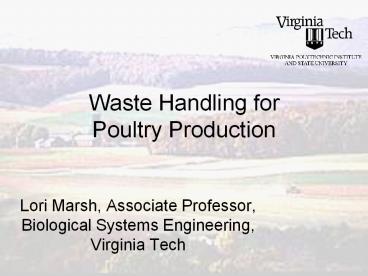Waste Handling for Poultry Production - PowerPoint PPT Presentation
1 / 9
Title:
Waste Handling for Poultry Production
Description:
Birds are typically raised in confinement, on a bedding material such as sawdust. ... In these systems, there is no bedding material on the floor. ... – PowerPoint PPT presentation
Number of Views:62
Avg rating:3.0/5.0
Title: Waste Handling for Poultry Production
1
Waste Handling for Poultry Production
- Lori Marsh, Associate Professor, Biological
Systems Engineering, Virginia Tech
2
The design of the waste handling system for
turkeys or chickens depends upon whether the goal
is to produce eggs or meat. While there is no
market for turkey eggs, there are
turkey-egg-producing facilities, which provide
pullets to be raised for meat.
3
Meat Production
- Birds are typically raised in confinement, on a
bedding material such as sawdust. The building
is cleaned out periodically and the resulting
litter (bedding plus manure) is stored until it
can be land applied.
4
A litter storage shed allows producers to land
apply litter when the nutrient content is of most
benefit to crops and when the chance of
environmental degradation is low. Litter should
not be applied to water-saturated or frozen
ground.
5
Litter is land applied according to a nutrient
management plan. Typically, application rates
are based on the nutrient uptake of the crops to
be grown. Historically, application rate was
based on crop nitrogen uptake. However, that
resulted in a build up of phosphorus in soils.
Today, most nutrient management plans are based
upon crop phosphorus uptake.
6
For egg production, the birds are typically caged
to allow for easy egg collection. In these
systems, there is no bedding material on the
floor. Typically manure handling systems for
layers include the following 1)A belt
collection system under the cages that removes
manure to a storage facility or 2) a
collection/storage space below the cages where
manure accumulates until it is removed or 3)
Flushing systems that use water to remove the
manure to a lagoon for storage. Regardless of
the handling system, the resulting manure is
eventually land applied according to a nutrient
management plan.
7
BMPs for Feed Management
- Feed formulated for life stage
- Phytase to reduce added P and excreted P
- Avoid feed spillage
- Avoid leaking waterers
8
Treatment Options
- for litter
- Additives Al2(SO4)3 Alum to reduce Ammonia
emissions and P solubility - Composting
- Pelletizing for commercial fertilizer
- Burning for energy output
- for layer manure
- Anaerobic lagoons and digesters
- Solids separation before lagoon
- Composting
9
BMPs for Land Application
- Nutrient Management Plan that includes
- Rate of application as a function of crop yield,
land nutrient status, manure nutrient content - Timing of applications
- Buffers
- Setbacks
- Calibration of application equipment































